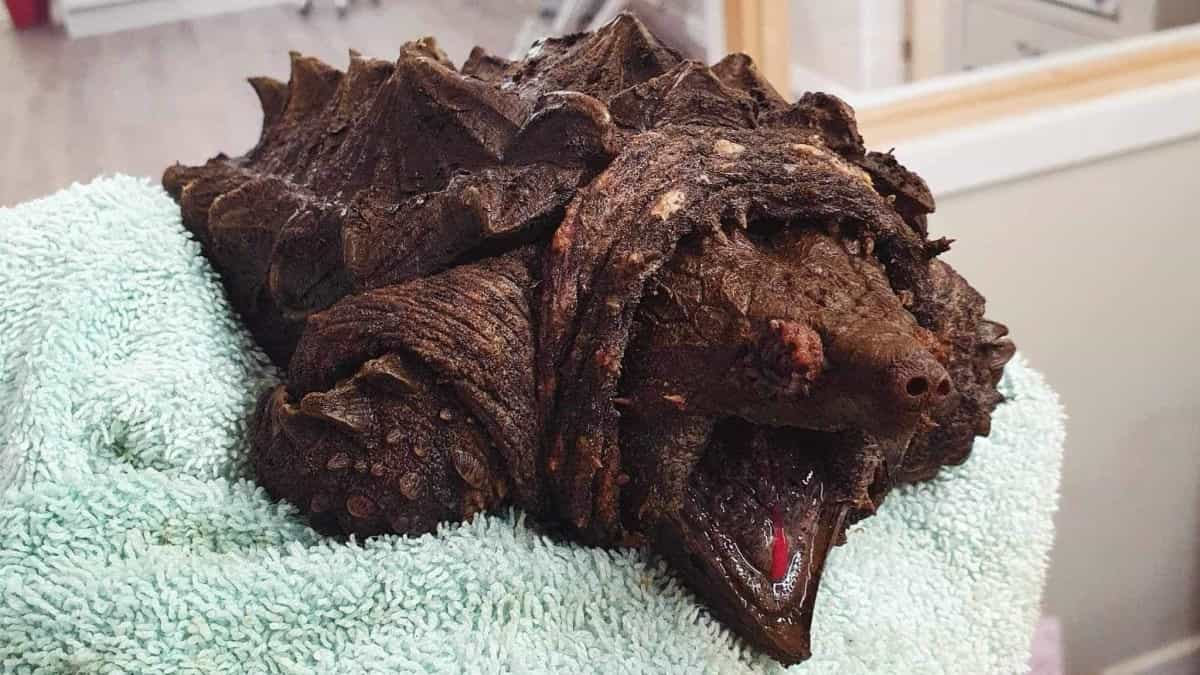Show table of content Hide table of content
A terrifying alligator snapping turtle has recently been discovered in an English lake, sparking concern among local wildlife experts. These formidable reptiles possess jaw strength capable of severing human fingers, making this unusual sighting particularly alarming for the local ecosystem and residents alike.
Dangerous predator found in Urswick Tarn
On February 5, a walker made an extraordinary discovery at Urswick Tarn lake in northern England. The individual spotted what appeared to be a prehistoric-looking creature lurking in the waters and quickly captured a photograph. After sharing the image on social media, Denise Chamberlain, a parish councillor with turtle expertise originally from Florida, identified the creature as an alligator snapping turtle.
“This turtle could inflict a nasty bite,” warned Chamberlain in a statement to The Guardian. “These turtles have a natural defense mechanism: when approached, they open their mouths. This type of creature could cause significant damage to fish populations and consume various local wildlife species, even if it doesn’t reproduce.”
Alligator snapping turtles (Macrochelys temminckii) are native to southern United States swamps and rivers. Their presence in English waters indicates human intervention, as these creatures would not naturally migrate to British waters. Their dinosaur-like appearance, complete with spikes along their shells, often leads people to mistake them for other exotic aquatic species when first encountered.
Powerful jaws that can cut through bone
What makes these turtles particularly dangerous is their extraordinary bite force. Unlike other turtle species that might retreat into their shells when threatened, alligator snappers possess jaw strength capable of severing human fingers or cutting through bones. This powerful bite serves as their primary defense mechanism and hunting tool in their native habitats.
As apex predators with voracious appetites, these turtles consume almost anything they encounter. Their hunting strategy involves lying motionless on water beds with their mouths open, using a worm-like appendage on their tongues to lure unsuspecting fish. This patient predatory tactic makes them efficient hunters, similar to how certain marine predators employ specialized hunting techniques to capture prey.
These impressive reptiles can reach weights of up to 80 kilograms, making them the largest freshwater turtles in the world. With lifespans extending to 70 years and no natural predators in English waters, an established population could devastate local ecosystems. The species has been classified as dangerous since 1997, requiring special certification for legal ownership—a regulation that was likely ignored by the turtle’s previous owners.
Animals A female sea lion refuses to mate with a male, causing a fight and the closure of the zoo.
Rescue operation and relocation
Upon identifying the creature, Chamberlain took decisive action to capture it safely. Armed with protective gloves and a basket filled with lake water, she successfully secured the turtle without injury. After a preliminary health check, Chamberlain fed the turtle raw chicken before transferring it to a veterinary clinic, where staff were astonished by their unusual patient.
Kate Hornby, veterinarian and clinic director, commented on the situation: “This is certainly the first of its kind we’ve seen at the clinic. We rarely receive reptiles, and when we do, it’s often because they’ve been kept inappropriately. It’s crucial to thoroughly research particular species before considering them as pets and ensure you have appropriate housing and knowledge.”
Veterinary staff affectionately named the turtle “Fluffy”—an ironically gentle name for such a fearsome creature. The name references the three-headed dog guarded by Hagrid in the Harry Potter series, a creature that, like this turtle, combines intimidating appearance with surprising vulnerability. Eventually, Fluffy was transferred to a specialized reptile center where experts could provide appropriate care, unlike the unfortunate experiences of other abandoned animals.
Conservation status and abandoned exotic pets
Alligator snapping turtles are listed as vulnerable by the International Union for Conservation of Nature (IUCN). In their native habitats, they face threats from habitat destruction, hunting, and illegal trafficking. While finding one in England raises immediate ecological concerns, it also highlights the broader issue of exotic pet abandonment.
Animals A hammerhead shark crashes down from the sky in South Carolina, halting a disc golf game.
Wildlife experts believe the turtle was likely kept as a pet before being released into the wild when its owners realized they couldn’t meet its substantial care requirements. This practice of abandoning exotic pets has become increasingly common, with owners often underestimating the commitment required for proper animal care.
The discovery of this powerful predator serves as a reminder about responsible pet ownership. While some collectors are willing to spend enormous sums for unusual pets, with some dogs fetching millions of dollars, many exotic animals ultimately end up abandoned when their care becomes overwhelming.
This case also highlights the importance of observation skills when encountering wildlife. Just as some people can spot camouflaged animals in complex settings, the walker’s ability to notice and document this unusual creature likely prevented potential injuries to unsuspecting lake visitors.
Finding unexpected creatures in unlikely places can lead to surprising discoveries, much like how some individuals have found valuable pearls in ordinary settings. However, unlike harmless surprises, this turtle’s presence represented a genuine threat requiring immediate intervention to protect both the public and local wildlife from its powerful bite capability.
Animals A wild elephant enters a convenience store and raids the food aisle.
The incident serves as a cautionary tale about the dangers of introducing non-native species into local ecosystems, where they can create imbalances with potentially surprising and alarming consequences for native wildlife populations.


